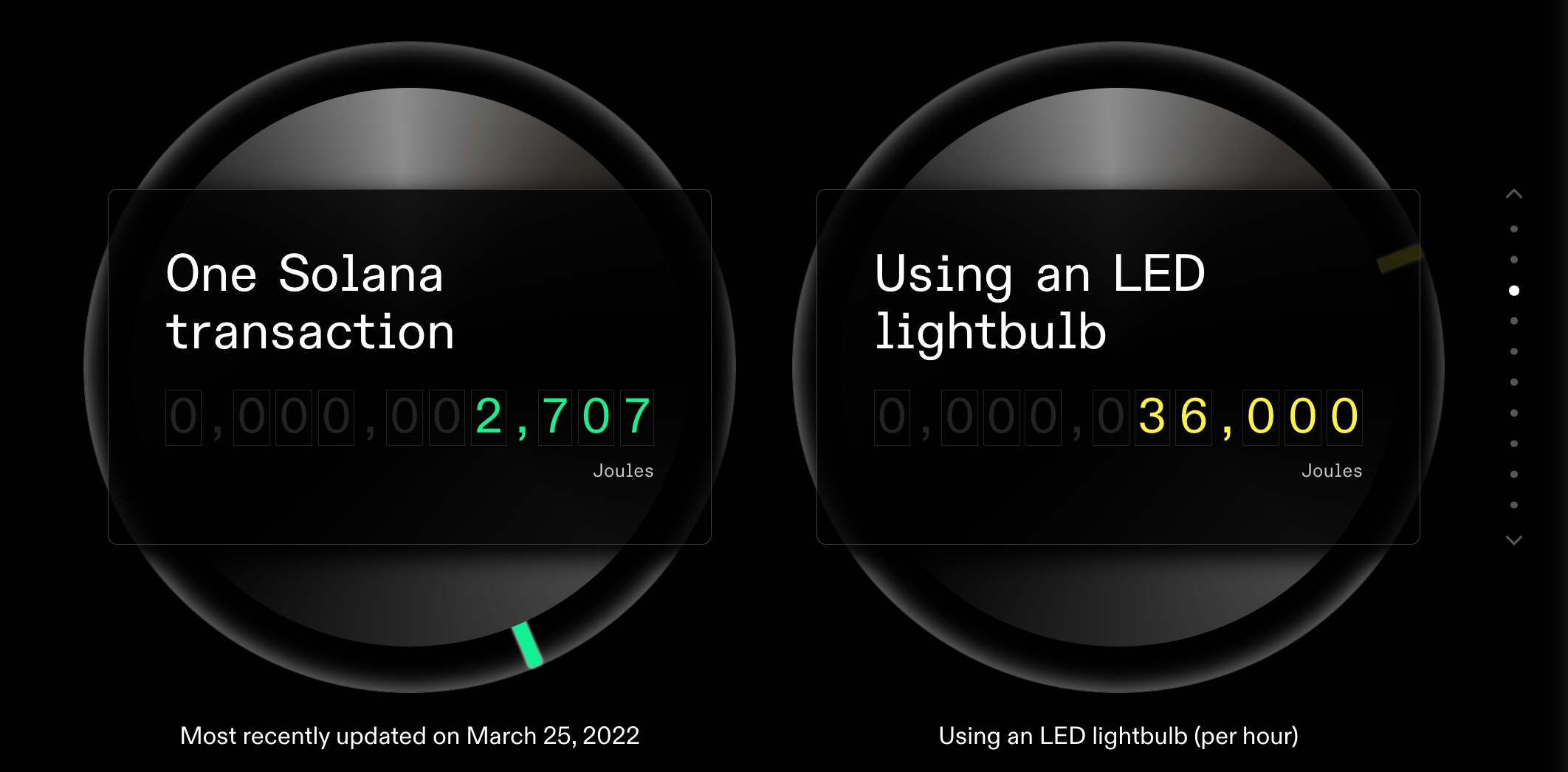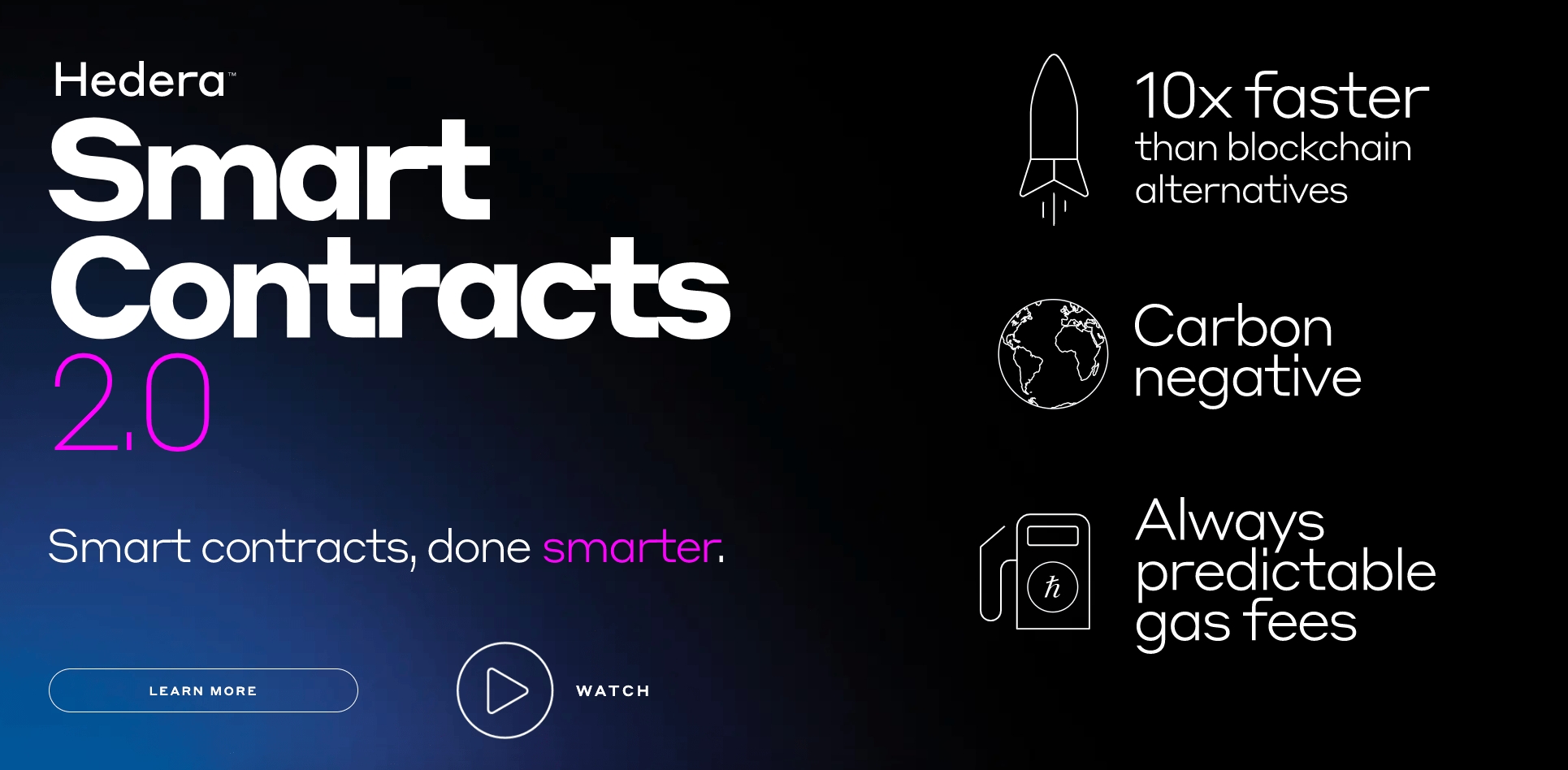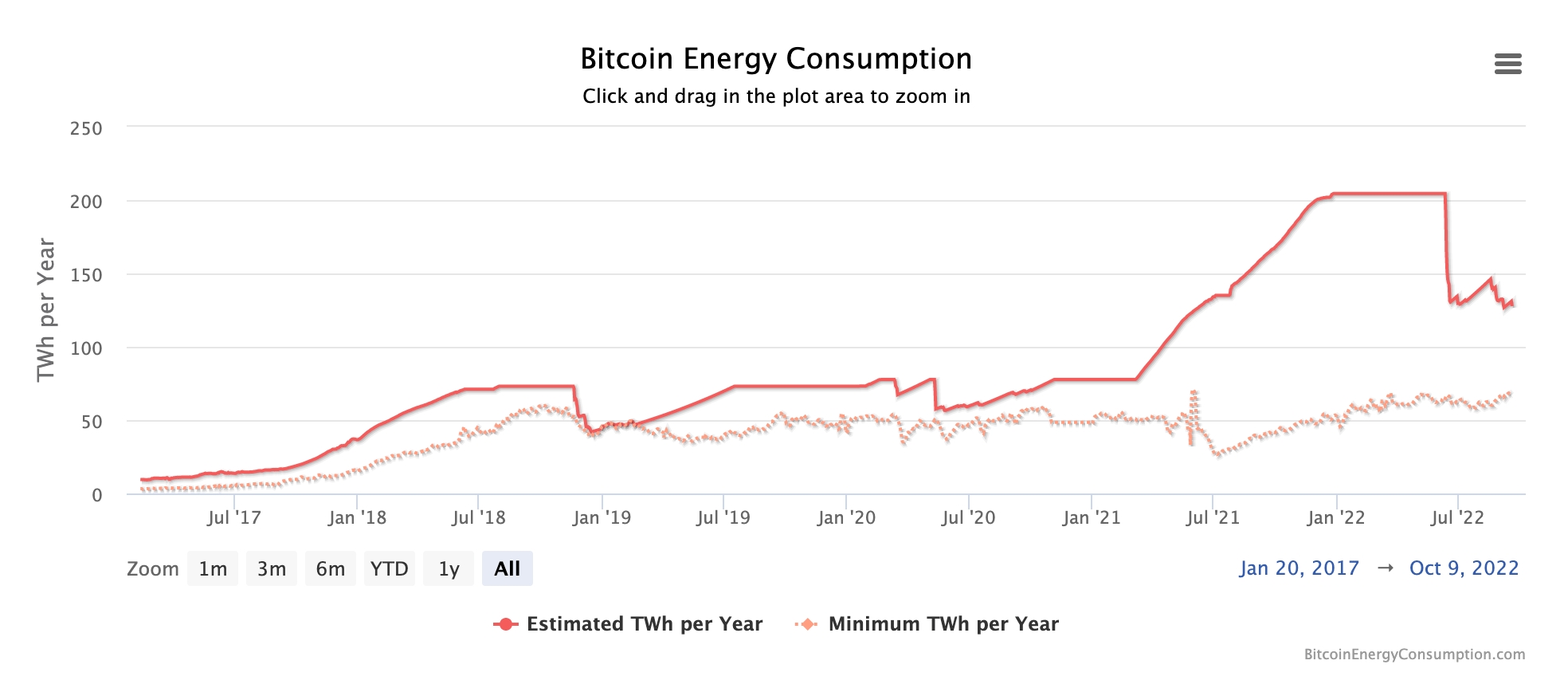The Most Energy-Efficient Cryptocurrency to Invest In – Top 10 Projects Reviewed

Disclaimer: The Industry Talk section features insights by crypto industry players and is not a part of the editorial content of Cryptonews.com.
The crypto market's reputation has undoubtedly been harmed by Bitcoin's substantial energy requirements, resulting from the network's Proof-of-Work (PoW) consensus protocol. However, many crypto projects now look to offer a more energy-efficient solution, making them more appealing to environmentally-conscious investors.
This guide discusses the most energy-efficient cryptocurrency projects on the market, diving into the technology that enables them to reduce their energy consumption drastically, before exploring why energy-efficient cryptos are so crucial in today's world.
The Most Energy-Efficient Cryptocurrency – Top 10 Projects for 2023
When looking for the crypto with the most upside, investors may wish to consider projects with reduced energy consumption. This is because the most energy-efficient crypto projects often employ cutting-edge technology – a factor that helps them become 'futureproof'.
With that in mind, listed below are 10 of the lowest energy cryptocurrency projects for 2023:
- C+Charge (CCHG) – The Most Energy-Efficient Crypto in 2023 Offering EV Drivers Rewards
- IMPT (IMPT) – Exciting Cabon Offset Protocol set for Huge 2023
- Ethereum (ETH) – Most Popular Energy-Efficient Cryptocurrency
- Stellar (XLM) – Best Energy-Efficient Cryptocurrency for Payment Processing
- Avalanche (AVAX) – The Most Energy-Efficient Crypto with High Scalability
- Solana (SOL) – Best Energy-Efficient Crypto for dApp Developers
- Cardano (ADA) – Low-Energy Blockchain with Peer-Reviewed Technology
- IOTA (MIOTA) – The Crypto with the Least Energy Consumption in the IoT Niche
- Hedera (HBAR) – Energy-Efficient Alternative to Blockchain Networks
- Tezos (XTZ) – Low-Power Blockchain with Innovative ‘Liquid Proof-of-Stake’ Protocol
Cryptoassets are highly volatile and unregulated. No consumer protection. Tax on profits may apply.
A Detailed Look at the Most Energy Efficient Cryptos for 2023
The lowest energy crypto projects are located in various market niches, highlighting the growing need for eco-friendly technologies across the board. Even many of the best metaverse coins now focus on sustainability, which has become an essential consideration for many investors.
Let’s take a closer look at the safe energy crypto projects listed above, exploring how their technology helps limit their carbon footprint.
1. C+Charge (CCHG) - The Most Energy-Efficient Crypto in 2023 Offering EV Drivers Rewards
Topping our list of the most energy-efficient crypto projects in 2023 is C+Charge, which will incentivize electric vehicle (EV) ownership by offering carbon credits to drivers as a reward.
The project will also democratize carbon credit ownership by taking them out of the hands of big businesses and into the hands of individuals.

Carbon credits are permits that allow holders to offset their carbon footprint by funding eco-friendly projects and businesses around the world, with one credit equal to one ton of CO2 emissions.
EV manufacturer Tesla, for example, generates billions of dollars annually by selling carbon credits to other companies that produce carbon emissions during the manufacturing and logistics processes.
C+Charge will allow EV drivers to earn carbon credits as a reward simply for recharging their car at a charging station.
Furthermore, C+Charge wants to help incentivize EV ownership by removing inefficiencies from the market - the mobile app will also allow drivers to find working charging stations, check wait times and also make recharging pricing more uniform.
The app will, therefore, make EV driving more energy efficient by cutting down on wasted trips, as well as offsetting the energy usage of charging stations that rely on national grids.
The project, which has a doxxed and KYC-verified development team, has already partnered with Flowcarbon to offer Goodness Nature Tokens (GNT) which are 1:1 backed by verified carbon regeneration projects.
Flowcarbon attracted more than $70 million of investment in 2022, with major venture capital funds such as Samsung Next, Invesco and a16z funding the development of the project.
C+Charge has also already partnered with Perfect Solutions Turkey, meaning they operate more 20% of charging stations in that country.
C+Charge has just launched its CCHG token presale, with tokens currently available to purchase for $0.013 each. Tokens will increase in price through four presale rounds, with the final price set at $0.0235 - an increase of 80%.
Of the 1 billion max CCHG supply, 40% are on offer during the presale, with no vesting period and a hard cap of $6.6 million. More information on the project can be found in the C+Charge whitepaper or by joining the Telegram group.
| Phase | Price | % of presale tokens | Number of Tokens | $ Value |
| 1 | $0.0130 | 40 | 160,000,000 | $2,080,000 |
| 2 | $0.0165 | 30 | 120,000,000 | $1,980,000 |
| 3 | $0.0200 | 20 | 80,000,000 | $1,600,000 |
| 4 | $0.0235 | 10 | 40,000,000 | $950,000 |
| TOTAL | 80% increase | 100% | 400,000,000 | $6.6 million |
2. IMPT (IMPT) – Exciting Cabon Offset Protocol set for Huge 2023
IMPT is another exciting carbon credits ecosystem that leverages the power of blockchain technology to improve accessibility and transparency.
Hosted on the Ethereum blockchain, IMPT's platform allows individuals to positively impact the environment through their everyday shopping activities. This is achieved through IMPT's exclusive partnerships, which comprise more than 10,000 leading brands, including Apple, Booking.com, Forever 21, and many more.

As detailed in IMPT’s whitepaper, each brand will dedicate a percentage of its sales margin to eco-friendly projects. In turn, this rewards shoppers with IMPT tokens for buying goods or services with these partner brands. Shoppers can then exchange their tokens into carbon credits through IMPT's built-in marketplace.
As mentioned above, carbon credits are a practical way for individuals and companies to offset their CO2 emissions. Each credit equates to one ton of CO2 (or greenhouse-gas equivalent), with these credits able to be traded on the secondary marketplace. Notably, IMPT allows credits to be 'retired' - meaning they are taken out of circulation permanently.
IMPT's innovative approach to carbon credit trading makes this one of our top picks for the most energy-efficient cryptocurrency on the market. Within IMPT's ecosystem, each carbon credit is structured as an NFT. Moreover, each credit is thoroughly audited by an independent company to ensure that Global Certification Protocols are followed.
Since carbon credits are structured as NFTs, holders can easily trade them on IMPT's marketplace, using the $IMPT token as the transactional currency. This allows holders to benefit from value increases driven by supply and demand factors.

Alternatively, carbon credit holders can 'retire' their credits, which results in the NFT being sent to a null wallet address. These holders are rewarded with a unique collectable NFT shared with the artist who created the design. Interestingly, these NFTs can also be traded on IMPT’s marketplace – providing another way to generate income.
Another exciting element of IMPT's ecosystem is that all participants will have an 'IMPT Score' based on their environmental impact. Participants can increase their score by completing various impactful tasks, such as shopping with partner retailers or retiring their carbon credits. IMPT scores are publicly-viewable, incentivizing individuals and companies to do more for the environment.
IMPT tokens have just launched on exchanges after one of the best crypto presales of 2022 saw it raise more than $20 million. With the platform set to launch in 2023, investors and experts are expecting a huge breakout once market conditions improve.
Those interested in IMPT can keep tabs on its progress by joining the official Telegram group.
3. Ethereum (ETH) – Most Popular Energy-Efficient Cryptocurrency
Taking the third spot on our list of the most energy-efficient cryptocurrency projects is Ethereum. Most crypto investors will have heard of Ethereum, as it remains the second-largest cryptocurrency as measured by market cap (behind Bitcoin).
However, many believe Ethereum is actually more valuable than Bitcoin due to its many use cases and the huge number of projects that are built on the blockchain.

As a smart contract-enabled blockchain, Ethereum provides the foundation for decentralized app (dApp) developers to host their creations. This has led to massive innovation in various high-growth sectors, including NFTs, the metaverse, and decentralized finance (DeFi).
The recent Ethereum merge saw the network move to a Proof-of-Stake (PoS) consensus protocol. This removes the problems associated with crypto mining energy consumption since Ethereum's blocks are now validated through staking. As a result, Ethereum's energy requirements are now drastically lower than before.
To put this into context, a recent report by CNN notes that the network will now use around 99.95% less energy than when it used a Proof-of-Work (PoW) consensus mechanism. In turn, this reduced crypto energy consumption has driven Ethereum into the limelight, helping change people's perceptions of the crypto market.
Overall, this energy-efficient crypto cryptocurrency tops our list due to its sheer size, making the team's focus on sustainability even more impressive. Finally, given that Ethereum's change to a PoS consensus protocol also makes the network much more scalable, this provides a solid foundation for further growth and the potential for ETH to become the greenest cryptocurrency on the market.
Cryptoassets are highly volatile and unregulated. No consumer protection. Tax on profits may apply.
4. Stellar (XLM) – Best Energy-Efficient Cryptocurrency for Payment Processing
Another environmentally energy-efficient cryptocurrency to be aware of is Stellar. Stellar remains one of the most-searched crypto projects globally due to its first-mover status. For those unaware, Stellar has made a name for itself in the payment processing space, attempting to revolutionize cross-border transactions.
Thanks to Stellar’s super-fast system, network users can send money anywhere, with transactions taking just five seconds to be processed. What’s more, these transactions cost just a fraction of a cent to complete – much cheaper than using the SWIFT network. Thanks to this innovative technology, Stellar has gone on to partner with leading institutions like IBM and MoneyGram.

Stellar can also be considered an energy-efficient cryptocurrency, as the network uses a unique ‘Proof-of-Agreement’ (PoA) consensus mechanism. According to the Stellar Foundation, the network consumes just 0.173 Wh of electricity per transaction. Moreover, nodes that help validate transactions only consume around 261,435 kWh of electricity annually.
In addition to its low-energy nature, Stellar has partnered with PricewaterhouseCoopers (PwC) to create a solid framework to accurately measure the network's energy use. Thanks to this, Stellar can now establish a carbon dioxide removal (CDR) commitment, helping reduce the network's carbon footprint.
Cryptoassets are highly volatile and unregulated. No consumer protection. Tax on profits may apply.
5. Avalanche (AVAX) – The Most Energy-Efficient Crypto with High Scalability
Avalanche is a super-fast blockchain network that emerged as a viable alternative to Ethereum in 2021. Instead of using just one chain, Avalanche adopts a 'multi-chain' approach, allowing it to increase its scalability significantly. To put this into context, Avalanche can handle 4,500 transactions per second (TPS), whilst Ethereum could previously only manage around 30 before ‘the Merge’.
Like many other energy-efficient cryptos, Avalanche uses a PoS mechanism to validate blocks. This makes AVAX one of the best proof-of-stake coins since transaction finality is achieved in less than two seconds. As a result, Avalanche has become a popular option for dApp developers and NFT creators looking for high scalability.

Interestingly, Avalanche is also an energy-efficient energy crypto backed by a recent report from the Crypto Carbon Ratings Institute (CCRI). This report found that the Avalanche blockchain uses just 0.0005% of the energy that the Bitcoin network does. It also uses just 0.0028% of Ethereum’s energy requirements – although this data was gathered before ‘the Merge’.
To put this into perspective, the total annual energy consumption of the Avalanche network equates to that of just 46 US households. This puts Avalanche in the third spot in the list of the most energy-efficient cryptocurrency projects, ahead of leading entities like Algorand and Cardano.
Cryptoassets are highly volatile and unregulated. No consumer protection. Tax on profits may apply.
6. Solana (SOL) – Best Energy-Efficient Crypto for dApp Developers
Solana has long been considered one of the best altcoins on the market, rising to prominence in 2021 thanks to its high level of scalability. Much like Ethereum, Solana has full support for smart contracts, making the network a viable option for dApp developers.
However, Solana differentiates itself by using a hybrid consensus mechanism. This approach combines the benefits of Proof-of-Stake and 'Proof-of-History', which means the network can theoretically handle up to 65,000 transactions per second (TPS), with finality of just 2.5 seconds.

Interestingly, Solana’s unique approach also makes the network extremely energy-efficient. As noted on Solana’s website, one network transaction uses just 2,707 Joules of energy – which is less power than three Google searches. In addition, minting an NFT on the Solana network uses around three times less energy than having an LED lightbulb on for an hour.
The Solana Foundation has also pledged funds to aid refrigerant destruction, which has been shown to be one of the best ways to reduce carbon emissions. In turn, this meant the Solana network achieved carbon neutrality in 2021.
Cryptoassets are highly volatile and unregulated. No consumer protection. Tax on profits may apply.
7. Cardano (ADA) – Low-Energy Blockchain with Peer-Reviewed Technology
Investors interested in the cryptos with the most potential may wish to consider Cardano. Cardano has been in the limelight over the past few years due to its systematic approach, which sees the development team rely heavily on peer-reviewed literature.
This approach, combined with the leadership of Ethereum co-founder Charles Hoskinson, has made Cardano an appealing option for dApp developers in various industries. Transactions on the Cardano network are validated using a PoS protocol called ‘Ouroboros’, which sees network participants stake their ADA tokens to receive block rewards.

This energy-efficient crypto mining alternative has made Cardano one of the most sustainable blockchains – so much so that the development team has even appointed a 'Group Head of Sustainability'. Moreover, Cardano's team also vets every single investment to ensure any pledged funds will make a positive real-world impact.
From an energy use perspective, Cardano uses a reported 48,851 kWh of electricity per year – which is less than that of five US households. Finally, Cardano's team even places significant emphasis on carbon offsetting, opting to use a green energy supplier for the Rotterdam office and urging employees to take the train where possible.
Cryptoassets are highly volatile and unregulated. No consumer protection. Tax on profits may apply.
8. IOTA (MIOTA) – The Crypto with the Least Energy Consumption in the IoT Niche
IOTA is a crypto with low energy consumption that aims to promote the idea of the Internet of Things (IoT). The IoT refers to the communication between different devices used in everyday life, ranging from TVs to smartphones and even refrigerators.
Many believe the concept of the IoT will become more evident in the years ahead, making IOTA one of the best long-term crypto projects to invest in. This is because IOTA helps facilitate transactions between devices using 'The Tangle' – a distributed ledger that does not rely on mining for validation.

Not only does this altogether remove transaction fees, but it also makes these transactions extremely energy-efficient. To put this into perspective, a recent blog post from IOTA’s team found that running the network's underlying software for an entire year would mean node operators only consume around 0.000009% of what the Bitcoin network does.
This means IOTA's annual node energy requirements are less than that of a typical German citizen’s – highlighting that this is a cryptocurrency that uses less energy than most. Moreover, IOTA's team has placed significant focus on transparency, pledging to continue showing accurate energy consumption data for the network.
Cryptoassets are highly volatile and unregulated. No consumer protection. Tax on profits may apply.
9. Hedera (HBAR) – Energy-Efficient Alternative to Blockchain Networks
Those looking for the crypto that uses the least energy may also wish to consider Hedera. Hedera occupies a unique position in the cryptocurrency market since this network doesn't actually use blockchain technology. Instead, Hedera uses a unique 'hashgraph' consensus mechanism designed by co-founder Leemon Baird.
This ‘hashgraph’ technology is relatively complex, although it is claimed to be faster and more secure than blockchain-based systems. Due to this, Hedera is highly scalable and can handle around 10,000 TPS with finality of just a few seconds.

Hedera has also emerged as one of the top trending cryptos due to the development team's focus on sustainability. This focus has resulted in Hedera becoming carbon negative thanks to the regular purchase of carbon offsets. Offset amounts are determined through Hedera's partnership with Terrapass to ensure accuracy and transparency.
What’s more, Hedera is also extremely energy-efficient and can process the equivalent of 10,000,000 transactions for the same amount of energy it takes the Bitcoin network to process one. Due to its low cryptocurrency energy consumption, Hedera will likely become increasingly popular as the need for sustainable networks grows.
Cryptoassets are highly volatile and unregulated. No consumer protection. Tax on profits may apply.
10. Tezos (XTZ) - Low-Power Blockchain with Innovative ‘Liquid Proof-of-Stake’ Protocol
Rounding off our list of the lowest energy crypto projects is Tezos. Tezos is often considered the best crypto by energy consumption due to its low carbon footprint, making the network appealing to dApp developers and NFT creators worldwide.
Tezos uses a 'liquid Proof-of-Stake' system to validate transactions, which is very similar to traditional PoS mechanisms, yet makes the validation process even more accessible. With this system, network participants can become 'bakers' if they hold more than 8,000 XTZ tokens or become delegators if they own less than this amount.

Each approach allows network participants to receive staking rewards, although the former obtains a higher percentage. In addition, this liquid PoS approach is extremely energy-efficient, consuming the same amount of energy per year as just 17 global citizens.
What’s more, Tezos’ technology will actually become more efficient as the network expands and transaction numbers increase, providing an incentive for environmentally-conscious dApp developers to get involved. Tezos has even partnered with PwC to assess the network’s carbon footprint, with the report freely available to all.
Cryptoassets are highly volatile and unregulated. No consumer protection. Tax on profits may apply.
How Does a Cryptocurrency Become Energy Efficient?
Although C+Charge, IMPT and Ethereum top our list of the lowest energy crypto projects, all of the networks listed in the previous section can be considered energy-efficient. But what does being energy-efficient actually mean? Let’s dive in and explore this question in more detail.
Many new cryptocurrency projects focus on sustainability to improve the crypto market's reputation. This reputation has unfortunately been damaged by Bitcoin's colossal energy requirements, which have caught the attention of the mainstream media. In a sense, this is understandable, considering the Bitcoin network consumes as much energy as a small country.

The reason for Bitcoin’s colossal energy requirements is the network’s Proof-of-Work (PoW) consensus mechanism, which relies on complex computing hardware to validate transactions. As the Bitcoin network has expanded, the need for more advanced equipment has also increased – leading to higher electricity requirements.
This is where the most energy-efficient crypto projects come in, as these projects offer an alternative to Bitcoin’s PoW consensus mechanism. The most common alternative is Proof-of-Stake (PoS), which completely eradicates the need for mining. As noted in a report by the FTSE Russell, PoS blockchains also offer yield opportunities, providing yet another benefit over PoW blockchains.

The result of using a PoS mechanism is that the associated network consumes much less electricity annually. Not only does this help repair the damage to the crypto market's reputation, but it also reduces the carbon footprint of these networks. Given the rapid growth of the crypto market, the latter point will be crucial in the years ahead.
However, just because a blockchain uses a PoS consensus mechanism doesn't mean it is entirely energy-efficient. There will always be energy requirements, which is why some blockchains, such as Solana, take additional measures to reduce (or remove) their carbon footprint. This trend is becoming more popular with low-energy cryptos, making these projects even more appealing to eco-conscious investors.
Why is Energy-Efficient Crypto So Important?
Many of the best altcoins now have a considerable focus on sustainability, enabling them to offer compelling use cases whilst remaining eco-friendly. But why are these energy-efficient cryptos considered so crucial in today's world?
Let's take a look at some of the most prominent reasons below:
Reduces Carbon Dioxide Emissions
Energy-efficient cryptocurrencies are crucial when it comes to reducing carbon dioxide emissions. According to Statista, energy-related carbon dioxide emissions reached 36.3 billion metric tons in 2021. For context, this was a 6% increase from the previous year.

However, the rise of energy-efficient cryptos can help reduce these CO2 emissions, as they make energy-intensive networks less popular. In addition, as sustainable cryptocurrencies become ‘the norm’, this will naturally make other industries sit up and take notice – prompting them to take action.
Provides an Option for Environmentally-Conscious Investors
The lowest-energy cryptocurrency projects also provide an option for environmentally-conscious investors. When Bitcoin was the ‘go-to’ in the market, this demographic of investors had their hands tied, meaning many had to sit on the sidelines.
This is no longer an issue, as there are now dozens of crypto projects that utilize energy-efficient technology. Additionally, as more capital flows to sustainable projects, less money will flow to energy-intensive projects, increasing the positive effects on the environment.
Helps Improve the Crypto Market’s Reputation
As touched on earlier, the growth of energy-efficient cryptos has had a hugely positive impact on the broader market’s reputation. Many of the fastest-growing cryptocurrency projects have raised awareness of the market's changing nature – and leading media outlets are beginning to take notice.

As the perception of the crypto market swings positive, this will naturally make cryptocurrencies a more attractive prospect for different investor demographics. In turn, as more capital flows into the market, energy-efficient crypto projects will have more significant resources to boost their sustainability agendas.
Promotes Technological Innovation
Finally, energy-efficient cryptocurrency projects are also vital for promoting technological innovation. This is clearly evidenced by the dramatic shift away from PoW consensus mechanisms, meaning that the likes of Bitcoin, Dogecoin, and Litecoin are being left behind.
In addition, due to the competitive nature of the crypto market, energy-efficient networks will be vying for the top spot regarding their positive environmental impact. This 'race to the top' provides a solid platform for innovation, which will undoubtedly have a positive effect on the environment as a whole.
How to Identify Energy-Efficient Cryptocurrencies
Investors looking for the best crypto to buy Reddit may wish to consider energy-efficient cryptocurrencies since they often use technology that reduces the chance of them becoming obsolete in the short term. With that in mind, detailed below are some of the best ways that investors can identify these cryptocurrencies:
Review the Underlying Technology
The easiest way to identify whether a cryptocurrency is energy-efficient is to review its technology. As noted throughout this article, environmentally-conscious investors should avoid PoW chains as this mechanism requires a tremendous amount of electricity. On the other hand, these investors may wish to consider PoS chains, which require far less electricity.
However, there are also technological innovations that 'improve' PoS mechanisms even further. For example, Solana uses a 'hybrid' system that incorporates Proof-of-Stake and 'Proof-of-History' elements. By looking for projects that focus on similar innovations, investors can easily identify which cryptos are doing their best to be energy-efficient.
Evaluate the Development Team
When looking for the best crypto to buy for energy efficiency, investors may also wish to evaluate the development team behind a potential project. Lead developers can easily be found on sites like LinkedIn, allowing investors to gain insight into their values and ambitions.

If one (or more) of the lead developers has a clear focus on sustainability, there's a good chance that they will be looking to ensure the project is as energy-efficient as possible. In addition, some projects (e.g. Cardano) even have roles that specifically focus on the project's carbon footprint.
Consider the Project’s Whitepaper & Roadmap
A project's whitepaper and roadmap are two crucial elements to consider before investing. However, they are just as important for investors looking to determine a project’s sustainability, as both should detail the project’s impact on the environment.
The whitepaper is especially important for this, as it will showcase the technology underpinning the project, allowing investors to determine whether it can be considered energy-efficient relative to similar projects. If a project's whitepaper doesn't mention its environmental impact whatsoever, then there's a good chance that energy efficiency isn't one of its top priorities.
Keep Tabs on Eco-Friendly Partnerships
Finally, investors can also uncover energy-efficient projects by looking out for partnership announcements in the crypto sector. When a project partners with a leading environmentally-conscious institution, it’s fair to say that sustainability is likely one of the development team’s core values.

An example is Solana's partnership with Watershed – a company that aims to help other companies reduce their carbon footprint. Through this partnership, Solana will be funding the destruction of refrigerants, which has been shown to have an immediate impact on reducing CO2 emissions.
The Most Energy-Efficient Cryptocurrency to Invest In – Conclusion
In summary, this article has taken an in-depth look at the most energy-efficient cryptocurrency projects on the market, diving into how they work and the ways in which their technology helps reduce energy consumption.
Investors looking to buy energy-efficient crypto today can do so by creating an account with eToro. eToro is regulated by tier-one entities like the FCA, CySEC, and FinCEN, ensuring investors are provided with the highest level of protection. Moreover, eToro allows positions to be opened from just $10 – with full support for PayPal, Skrill, and Neteller deposits.
Our top pick for the most energy-efficient crypto project is C+Charge, which will incentivize electric vehicle ownership by offering carbon credits as rewards to EV drivers simply for recharging.
The project will also remove inefficiencies out of EV ownership - such as long waiting times, varied pricing and broken charging points - by offering diagnostic information in a mobile app. The C+Charge presale has just launched with CCHG tokens on sale for $0.013 each during the first of four stages.
IMPT and Ethereum are our other two most energy-efficient projects to invest in.
FAQs
Which cryptocurrencies are energy-efficient?
All of the cryptocurrencies listed in this article are considered 'energy-efficient' due to their eco-friendly consensus protocols. C+Charge and IMPT are our two top picks as projects that offer carbon credits in extremely different ways. Ethereum is another leader in this regard, as 'the Merge' has reduced the network's energy requirements by a whopping 99.95%.
What crypto uses the least energy?
Blockchain networks like Tezos, Avalanche, and Solana have all been found to use the lowest amounts of energy per year, thanks to their PoS consensus protocols. However, many other blockchains make up for their slightly-higher energy requirements by offsetting emissions through purchasing carbon offsets or powering their offices using green energy sources.














